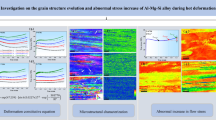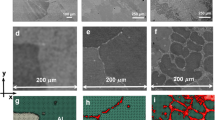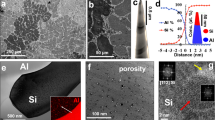Abstract
In this paper, an attempt is made to predict the microstructure evolution in Al–Si alloy two-dimensional (2D) system under shear loading conditions. The importance of damage accumulation events in delamination wear is studied. The conducted molecular dynamics (MD) simulations are based on the Modified Embedded Atom Method (MEAM). As a result a cohesive zone type of model relating the shear stress and the shear displacement has been suggested.








Similar content being viewed by others
References
Alpas, A., Embury, J.: The role of subsurface deformation and strain localization on the sliding wear behaviour of laminated composites. Wear 146, 285–300 (1991)
Alpas, A., Hu, H., Zhang, J.: Plastic deformation and damage accumulation below the worn surfaces. Wear 162, 188–195 (1993)
Baskes, M.I.: Modified embedded-atom potentials for cubic materials and impurities. Phys. Rev. B 46(5), 2727–2742 (1992)
Baskes, M.I., Nelson, J.S., Wright, A.F.: Semiempirical modified embedded-atom potentials for silicon and germanium. Phys. Rev. B 40(9), 6085–6100 (1989)
Daw, M.S., Baskes, M.I.: Semiempirical, quantum mechanical calculation of hydrogen embrittlement in metals. Phys. Rev. Lett. 50, 1285–1288 (1983)
Daw, M.S., Baskes, M.I.: Embedded-atom method: derivation and application to impurities, surfaces, and other defects in metals. Phys. Rev. B 29(12), 6443–6453 (1984)
Gall, K., Horstemeyer, M.F., Van Schilfgaarde, M., Baskes, M.I.: Atomistic simulations on the tensile debonding of an aluminum-silicon interface. J. Mech. Phys. Solids 48(10), 2183–2212 (2000)
Needleman, A.: An analysis of decohesion along an imperfect interface. Int. J. Frac. 42, 21–40 (1990)
Perrin, C., Rainforth, W.: Work hardening behavior at the worn surface of Al–Cu and Al–Si alloys. Wear 203–204, 171–179 (1997)
Tvergaard, V., Hutchinson, J.: Toughness of an interface along a thin ductile layer joining elastic solids. Phil. Mag. A 70, 641–656 (1994)
Warmuzek, M.: Metallographic techniques for aluminum and its alloys, metallography and microstructures. In: ASM Handbook, vol. 9, pp. 711–751. ASM International (2004)
Yamakov, V., Wolf, D., Phillpot, S.R., Mukharjee, A.K., Gleiter, H.: Dislocation processes in the deformation of nanocrystalline aluminium by molecular-dynamics simulation. Nat. Mater. 1(1), 45–48 (2002)
Yamakov, V., Wolf, D., Phillpot, S., Mukharjee, A., Gleiter, H.: Deformation-mechanism map for nanocrystalline metals by molecular-dynamics simulation. Nat. Mater. 3, 43–47 (2004)
Zhang, J., Alpas, A.: Delamination wear in ductile matrials containing 2nd phase particles. Mater Sci Eng A 160, 25–35 (1993)
Author information
Authors and Affiliations
Corresponding author
Appendix A
Appendix A
The forces acting on the atoms are readily determined
The second term in Eq. A1 can be reorganized
Using the definition of the relative electron density, \( \hat{\rho }_{i} \) (Eq. 3), \( \hat{\rho }^{\prime }_{i} \) is obtained
The necessary derivatives of the partial electron densities are given as
Finally the differentiation of the electron densities yields
The first term in Eq. A1 represents the forces due to the pair interactions. The magnitude of \( \phi^{\prime} (r_{kj})\) can be obtain from Eq. A3
where
Rights and permissions
About this article
Cite this article
Inci, L., Tavoosfard, S. & Stoilov, V. Microstructure evolution of Al–Si alloys under shear loading. Int J Mech Mater Des 4, 197–203 (2008). https://doi.org/10.1007/s10999-007-9035-1
Received:
Accepted:
Published:
Issue Date:
DOI: https://doi.org/10.1007/s10999-007-9035-1




